BUSN20017 - Effective Business Communication: A Reflective Essay
VerifiedAdded on 2023/06/07
|10
|2471
|412
Essay
AI Summary
This reflective essay summarizes a student's learning journey in an Effective Business Communication unit (BUSN20017). It highlights key concepts from each of the ten weeks, including ethical communication, non-verbal communication, communication mediums, academic writing, public speaking, intercultural communication, organizational communication, teamwork, and interpersonal communication. The essay discusses the application of these concepts to future career aspirations, referencing literature to support the importance of both verbal and non-verbal communication in the business world. The student emphasizes the value of public speaking skills and the ability to choose the appropriate communication medium for different situations. Desklib provides access to this essay and other solved assignments for students.
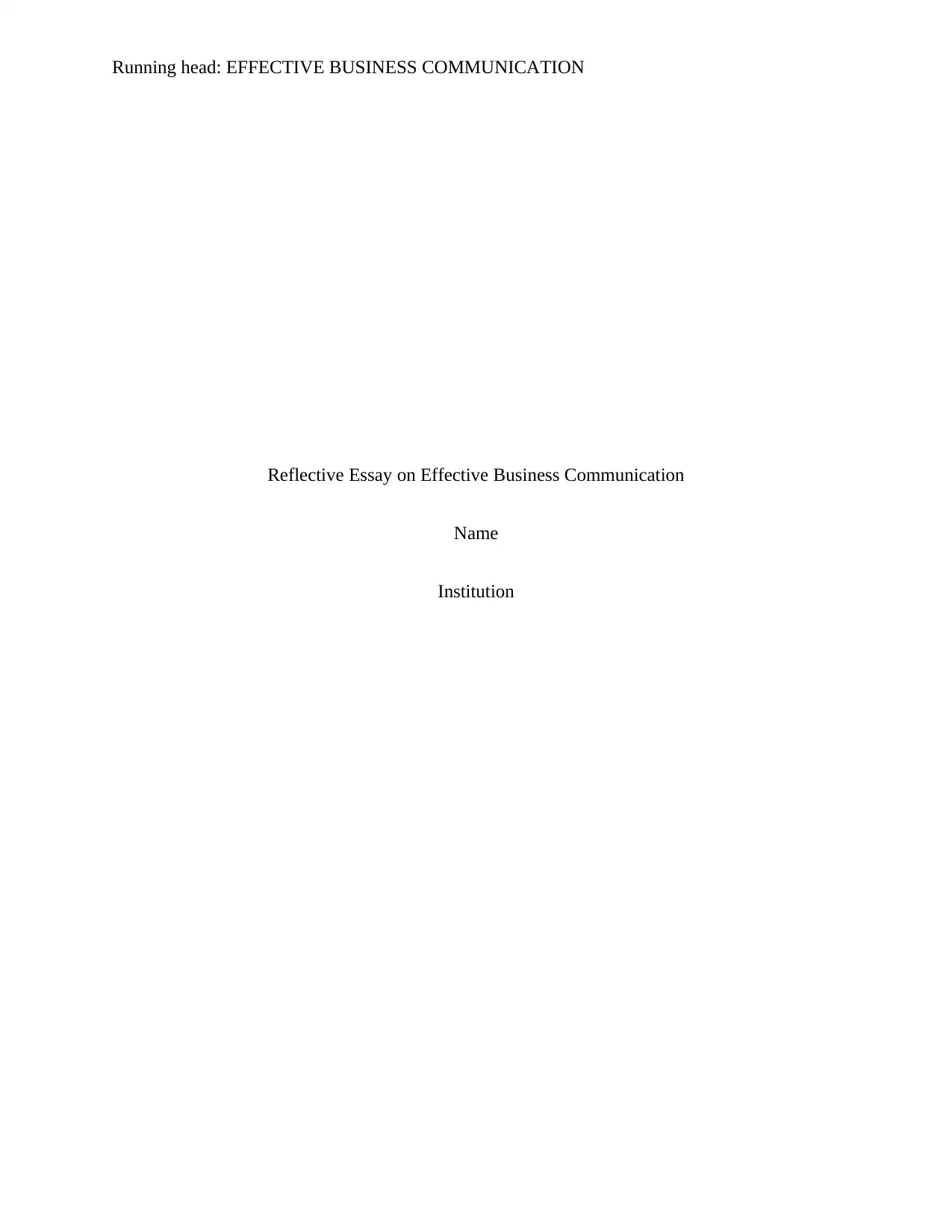
Running head: EFFECTIVE BUSINESS COMMUNICATION
Reflective Essay on Effective Business Communication
Name
Institution
Reflective Essay on Effective Business Communication
Name
Institution
Paraphrase This Document
Need a fresh take? Get an instant paraphrase of this document with our AI Paraphraser
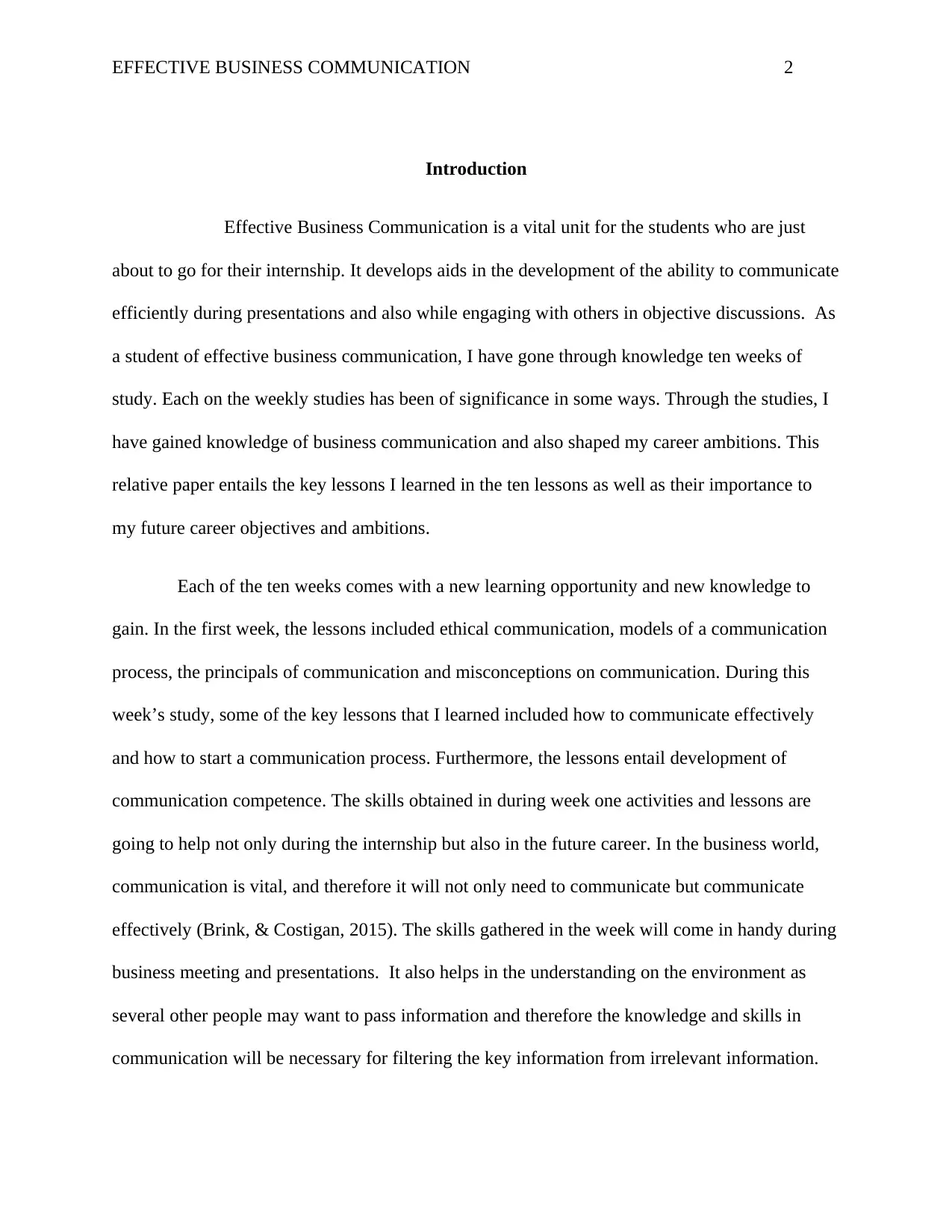
EFFECTIVE BUSINESS COMMUNICATION 2
Introduction
Effective Business Communication is a vital unit for the students who are just
about to go for their internship. It develops aids in the development of the ability to communicate
efficiently during presentations and also while engaging with others in objective discussions. As
a student of effective business communication, I have gone through knowledge ten weeks of
study. Each on the weekly studies has been of significance in some ways. Through the studies, I
have gained knowledge of business communication and also shaped my career ambitions. This
relative paper entails the key lessons I learned in the ten lessons as well as their importance to
my future career objectives and ambitions.
Each of the ten weeks comes with a new learning opportunity and new knowledge to
gain. In the first week, the lessons included ethical communication, models of a communication
process, the principals of communication and misconceptions on communication. During this
week’s study, some of the key lessons that I learned included how to communicate effectively
and how to start a communication process. Furthermore, the lessons entail development of
communication competence. The skills obtained in during week one activities and lessons are
going to help not only during the internship but also in the future career. In the business world,
communication is vital, and therefore it will not only need to communicate but communicate
effectively (Brink, & Costigan, 2015). The skills gathered in the week will come in handy during
business meeting and presentations. It also helps in the understanding on the environment as
several other people may want to pass information and therefore the knowledge and skills in
communication will be necessary for filtering the key information from irrelevant information.
Introduction
Effective Business Communication is a vital unit for the students who are just
about to go for their internship. It develops aids in the development of the ability to communicate
efficiently during presentations and also while engaging with others in objective discussions. As
a student of effective business communication, I have gone through knowledge ten weeks of
study. Each on the weekly studies has been of significance in some ways. Through the studies, I
have gained knowledge of business communication and also shaped my career ambitions. This
relative paper entails the key lessons I learned in the ten lessons as well as their importance to
my future career objectives and ambitions.
Each of the ten weeks comes with a new learning opportunity and new knowledge to
gain. In the first week, the lessons included ethical communication, models of a communication
process, the principals of communication and misconceptions on communication. During this
week’s study, some of the key lessons that I learned included how to communicate effectively
and how to start a communication process. Furthermore, the lessons entail development of
communication competence. The skills obtained in during week one activities and lessons are
going to help not only during the internship but also in the future career. In the business world,
communication is vital, and therefore it will not only need to communicate but communicate
effectively (Brink, & Costigan, 2015). The skills gathered in the week will come in handy during
business meeting and presentations. It also helps in the understanding on the environment as
several other people may want to pass information and therefore the knowledge and skills in
communication will be necessary for filtering the key information from irrelevant information.
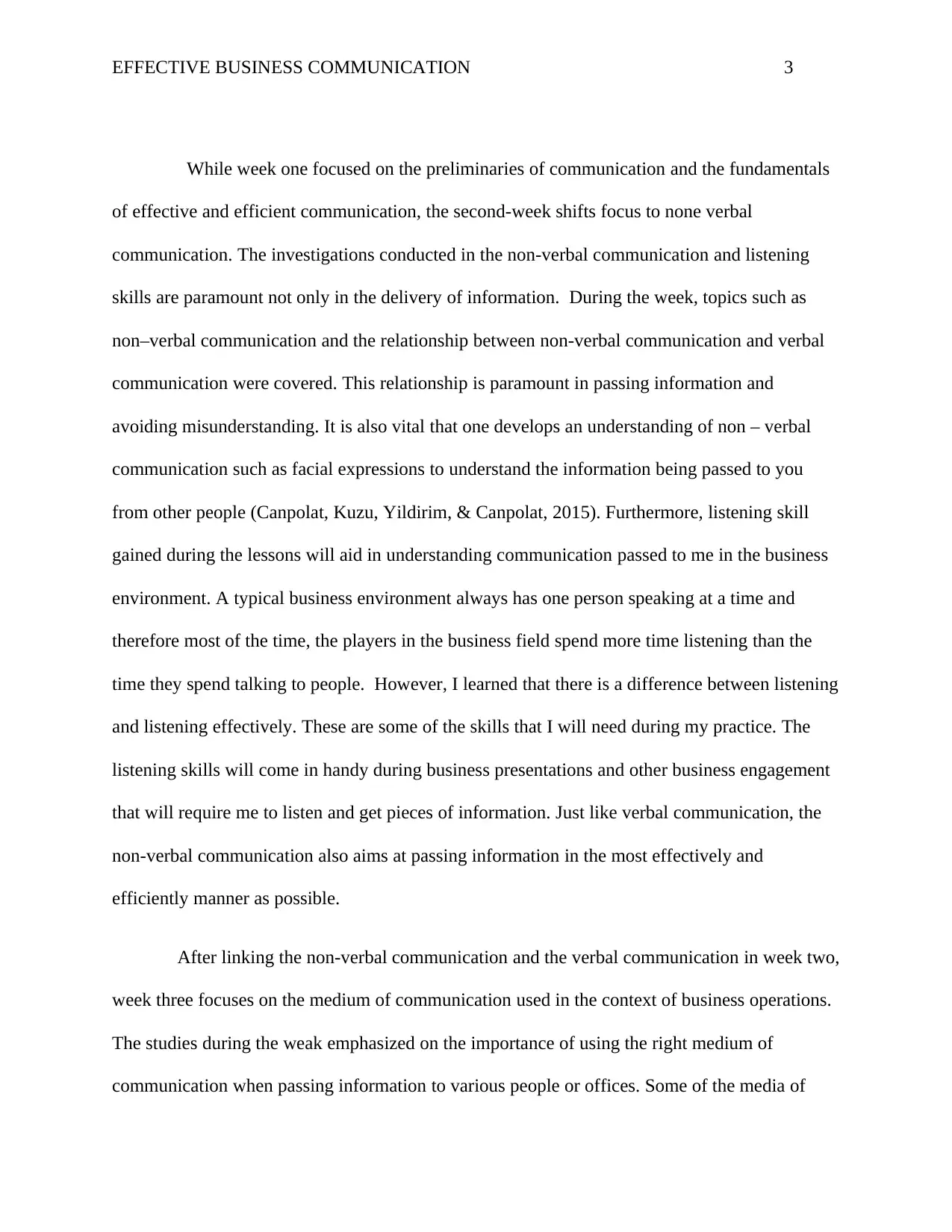
EFFECTIVE BUSINESS COMMUNICATION 3
While week one focused on the preliminaries of communication and the fundamentals
of effective and efficient communication, the second-week shifts focus to none verbal
communication. The investigations conducted in the non-verbal communication and listening
skills are paramount not only in the delivery of information. During the week, topics such as
non–verbal communication and the relationship between non-verbal communication and verbal
communication were covered. This relationship is paramount in passing information and
avoiding misunderstanding. It is also vital that one develops an understanding of non – verbal
communication such as facial expressions to understand the information being passed to you
from other people (Canpolat, Kuzu, Yildirim, & Canpolat, 2015). Furthermore, listening skill
gained during the lessons will aid in understanding communication passed to me in the business
environment. A typical business environment always has one person speaking at a time and
therefore most of the time, the players in the business field spend more time listening than the
time they spend talking to people. However, I learned that there is a difference between listening
and listening effectively. These are some of the skills that I will need during my practice. The
listening skills will come in handy during business presentations and other business engagement
that will require me to listen and get pieces of information. Just like verbal communication, the
non-verbal communication also aims at passing information in the most effectively and
efficiently manner as possible.
After linking the non-verbal communication and the verbal communication in week two,
week three focuses on the medium of communication used in the context of business operations.
The studies during the weak emphasized on the importance of using the right medium of
communication when passing information to various people or offices. Some of the media of
While week one focused on the preliminaries of communication and the fundamentals
of effective and efficient communication, the second-week shifts focus to none verbal
communication. The investigations conducted in the non-verbal communication and listening
skills are paramount not only in the delivery of information. During the week, topics such as
non–verbal communication and the relationship between non-verbal communication and verbal
communication were covered. This relationship is paramount in passing information and
avoiding misunderstanding. It is also vital that one develops an understanding of non – verbal
communication such as facial expressions to understand the information being passed to you
from other people (Canpolat, Kuzu, Yildirim, & Canpolat, 2015). Furthermore, listening skill
gained during the lessons will aid in understanding communication passed to me in the business
environment. A typical business environment always has one person speaking at a time and
therefore most of the time, the players in the business field spend more time listening than the
time they spend talking to people. However, I learned that there is a difference between listening
and listening effectively. These are some of the skills that I will need during my practice. The
listening skills will come in handy during business presentations and other business engagement
that will require me to listen and get pieces of information. Just like verbal communication, the
non-verbal communication also aims at passing information in the most effectively and
efficiently manner as possible.
After linking the non-verbal communication and the verbal communication in week two,
week three focuses on the medium of communication used in the context of business operations.
The studies during the weak emphasized on the importance of using the right medium of
communication when passing information to various people or offices. Some of the media of
⊘ This is a preview!⊘
Do you want full access?
Subscribe today to unlock all pages.

Trusted by 1+ million students worldwide
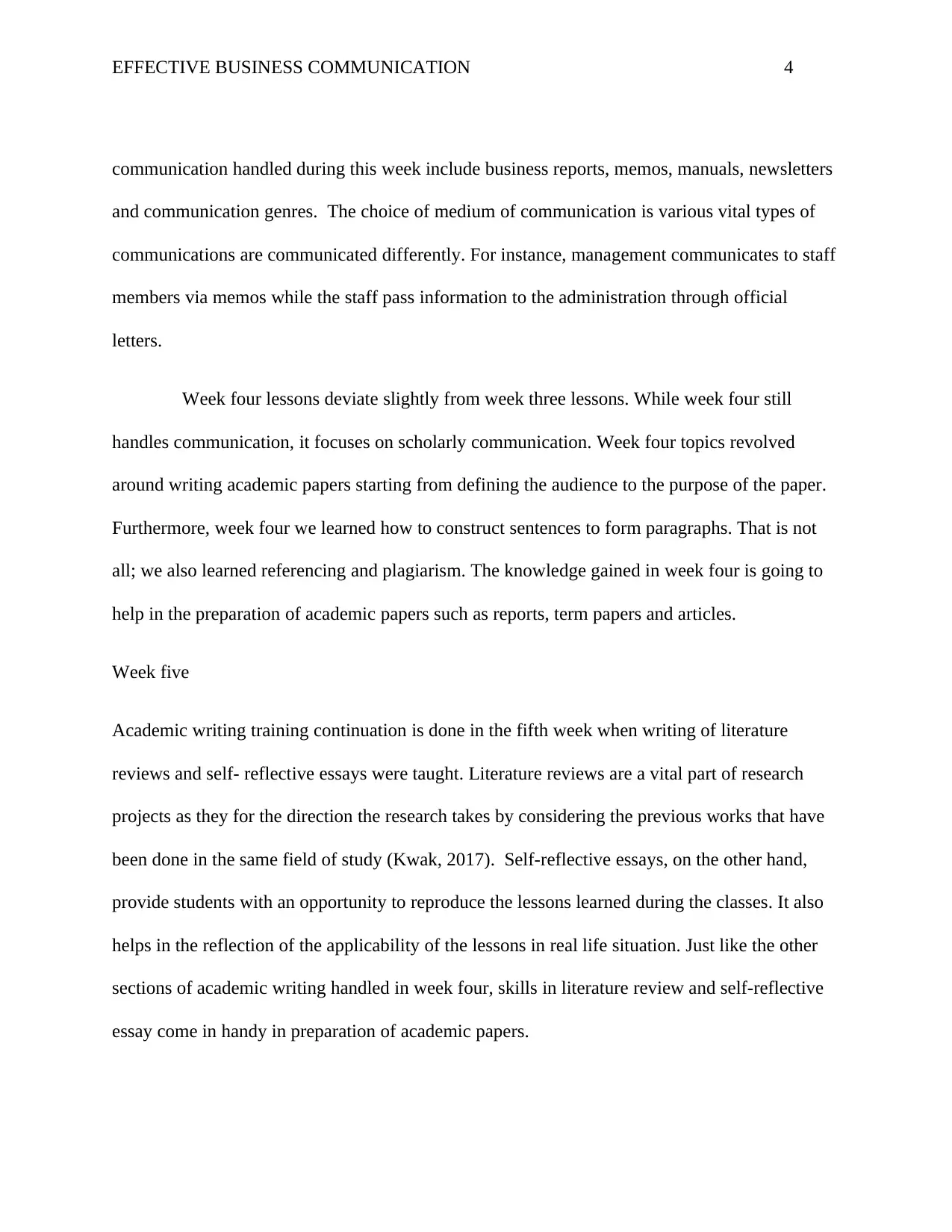
EFFECTIVE BUSINESS COMMUNICATION 4
communication handled during this week include business reports, memos, manuals, newsletters
and communication genres. The choice of medium of communication is various vital types of
communications are communicated differently. For instance, management communicates to staff
members via memos while the staff pass information to the administration through official
letters.
Week four lessons deviate slightly from week three lessons. While week four still
handles communication, it focuses on scholarly communication. Week four topics revolved
around writing academic papers starting from defining the audience to the purpose of the paper.
Furthermore, week four we learned how to construct sentences to form paragraphs. That is not
all; we also learned referencing and plagiarism. The knowledge gained in week four is going to
help in the preparation of academic papers such as reports, term papers and articles.
Week five
Academic writing training continuation is done in the fifth week when writing of literature
reviews and self- reflective essays were taught. Literature reviews are a vital part of research
projects as they for the direction the research takes by considering the previous works that have
been done in the same field of study (Kwak, 2017). Self-reflective essays, on the other hand,
provide students with an opportunity to reproduce the lessons learned during the classes. It also
helps in the reflection of the applicability of the lessons in real life situation. Just like the other
sections of academic writing handled in week four, skills in literature review and self-reflective
essay come in handy in preparation of academic papers.
communication handled during this week include business reports, memos, manuals, newsletters
and communication genres. The choice of medium of communication is various vital types of
communications are communicated differently. For instance, management communicates to staff
members via memos while the staff pass information to the administration through official
letters.
Week four lessons deviate slightly from week three lessons. While week four still
handles communication, it focuses on scholarly communication. Week four topics revolved
around writing academic papers starting from defining the audience to the purpose of the paper.
Furthermore, week four we learned how to construct sentences to form paragraphs. That is not
all; we also learned referencing and plagiarism. The knowledge gained in week four is going to
help in the preparation of academic papers such as reports, term papers and articles.
Week five
Academic writing training continuation is done in the fifth week when writing of literature
reviews and self- reflective essays were taught. Literature reviews are a vital part of research
projects as they for the direction the research takes by considering the previous works that have
been done in the same field of study (Kwak, 2017). Self-reflective essays, on the other hand,
provide students with an opportunity to reproduce the lessons learned during the classes. It also
helps in the reflection of the applicability of the lessons in real life situation. Just like the other
sections of academic writing handled in week four, skills in literature review and self-reflective
essay come in handy in preparation of academic papers.
Paraphrase This Document
Need a fresh take? Get an instant paraphrase of this document with our AI Paraphraser
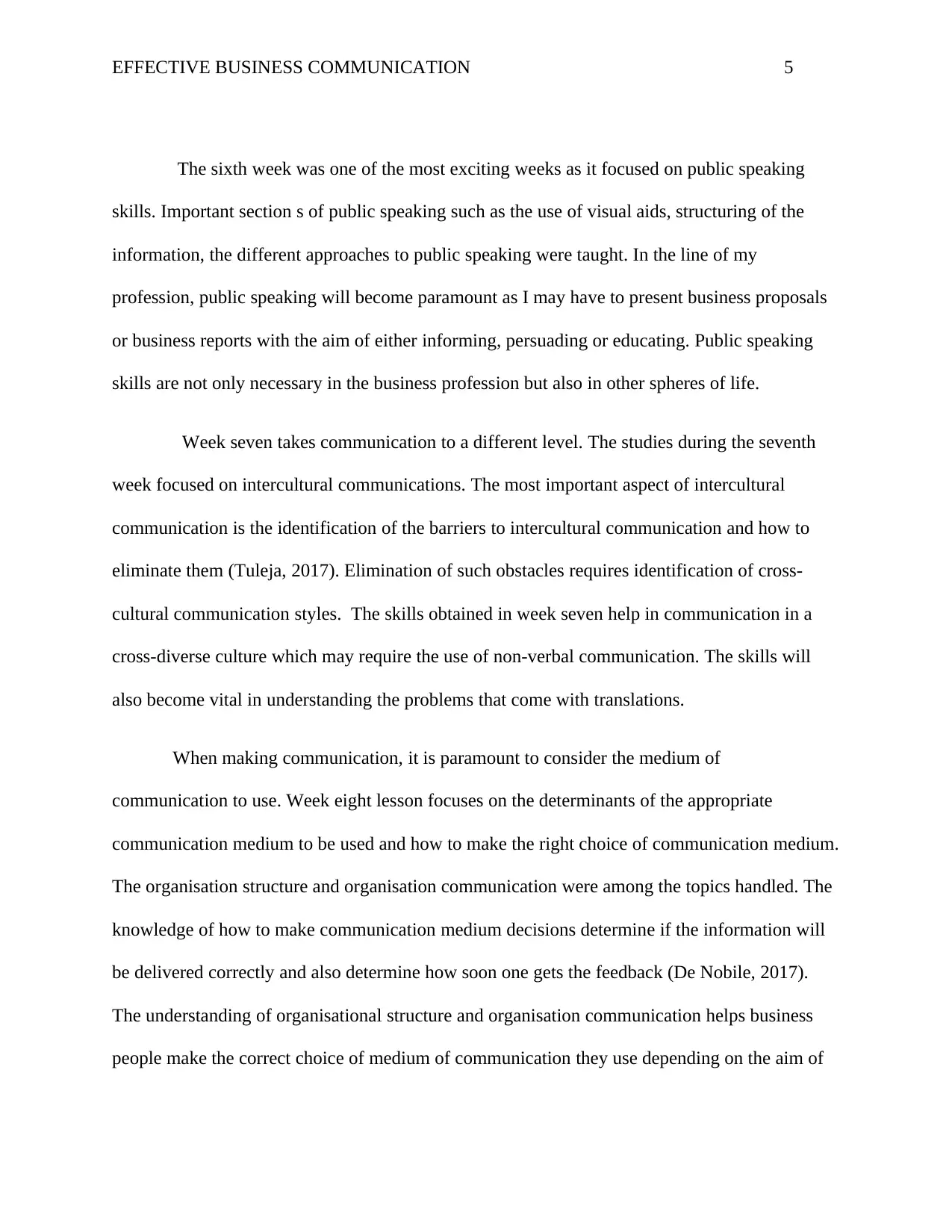
EFFECTIVE BUSINESS COMMUNICATION 5
The sixth week was one of the most exciting weeks as it focused on public speaking
skills. Important section s of public speaking such as the use of visual aids, structuring of the
information, the different approaches to public speaking were taught. In the line of my
profession, public speaking will become paramount as I may have to present business proposals
or business reports with the aim of either informing, persuading or educating. Public speaking
skills are not only necessary in the business profession but also in other spheres of life.
Week seven takes communication to a different level. The studies during the seventh
week focused on intercultural communications. The most important aspect of intercultural
communication is the identification of the barriers to intercultural communication and how to
eliminate them (Tuleja, 2017). Elimination of such obstacles requires identification of cross-
cultural communication styles. The skills obtained in week seven help in communication in a
cross-diverse culture which may require the use of non-verbal communication. The skills will
also become vital in understanding the problems that come with translations.
When making communication, it is paramount to consider the medium of
communication to use. Week eight lesson focuses on the determinants of the appropriate
communication medium to be used and how to make the right choice of communication medium.
The organisation structure and organisation communication were among the topics handled. The
knowledge of how to make communication medium decisions determine if the information will
be delivered correctly and also determine how soon one gets the feedback (De Nobile, 2017).
The understanding of organisational structure and organisation communication helps business
people make the correct choice of medium of communication they use depending on the aim of
The sixth week was one of the most exciting weeks as it focused on public speaking
skills. Important section s of public speaking such as the use of visual aids, structuring of the
information, the different approaches to public speaking were taught. In the line of my
profession, public speaking will become paramount as I may have to present business proposals
or business reports with the aim of either informing, persuading or educating. Public speaking
skills are not only necessary in the business profession but also in other spheres of life.
Week seven takes communication to a different level. The studies during the seventh
week focused on intercultural communications. The most important aspect of intercultural
communication is the identification of the barriers to intercultural communication and how to
eliminate them (Tuleja, 2017). Elimination of such obstacles requires identification of cross-
cultural communication styles. The skills obtained in week seven help in communication in a
cross-diverse culture which may require the use of non-verbal communication. The skills will
also become vital in understanding the problems that come with translations.
When making communication, it is paramount to consider the medium of
communication to use. Week eight lesson focuses on the determinants of the appropriate
communication medium to be used and how to make the right choice of communication medium.
The organisation structure and organisation communication were among the topics handled. The
knowledge of how to make communication medium decisions determine if the information will
be delivered correctly and also determine how soon one gets the feedback (De Nobile, 2017).
The understanding of organisational structure and organisation communication helps business
people make the correct choice of medium of communication they use depending on the aim of
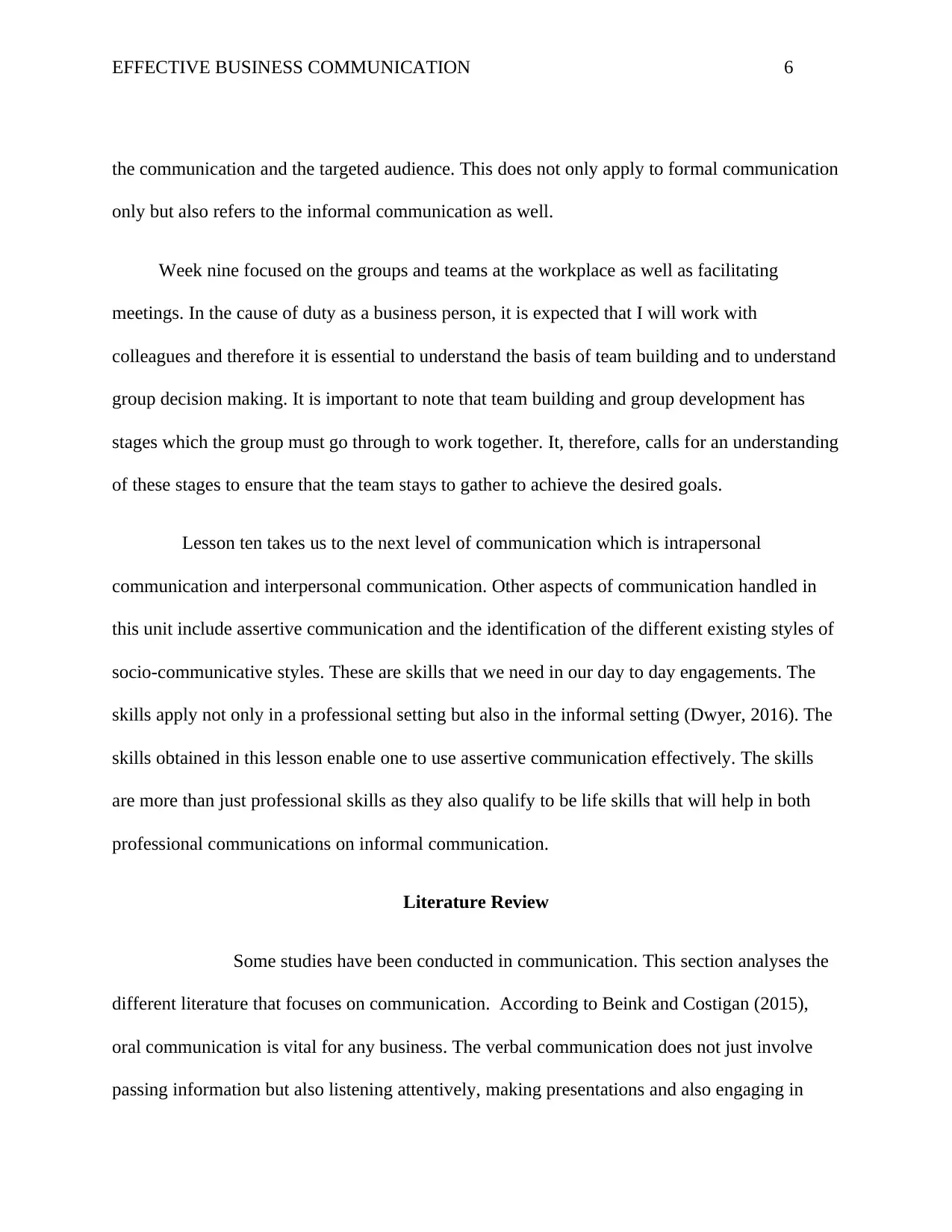
EFFECTIVE BUSINESS COMMUNICATION 6
the communication and the targeted audience. This does not only apply to formal communication
only but also refers to the informal communication as well.
Week nine focused on the groups and teams at the workplace as well as facilitating
meetings. In the cause of duty as a business person, it is expected that I will work with
colleagues and therefore it is essential to understand the basis of team building and to understand
group decision making. It is important to note that team building and group development has
stages which the group must go through to work together. It, therefore, calls for an understanding
of these stages to ensure that the team stays to gather to achieve the desired goals.
Lesson ten takes us to the next level of communication which is intrapersonal
communication and interpersonal communication. Other aspects of communication handled in
this unit include assertive communication and the identification of the different existing styles of
socio-communicative styles. These are skills that we need in our day to day engagements. The
skills apply not only in a professional setting but also in the informal setting (Dwyer, 2016). The
skills obtained in this lesson enable one to use assertive communication effectively. The skills
are more than just professional skills as they also qualify to be life skills that will help in both
professional communications on informal communication.
Literature Review
Some studies have been conducted in communication. This section analyses the
different literature that focuses on communication. According to Beink and Costigan (2015),
oral communication is vital for any business. The verbal communication does not just involve
passing information but also listening attentively, making presentations and also engaging in
the communication and the targeted audience. This does not only apply to formal communication
only but also refers to the informal communication as well.
Week nine focused on the groups and teams at the workplace as well as facilitating
meetings. In the cause of duty as a business person, it is expected that I will work with
colleagues and therefore it is essential to understand the basis of team building and to understand
group decision making. It is important to note that team building and group development has
stages which the group must go through to work together. It, therefore, calls for an understanding
of these stages to ensure that the team stays to gather to achieve the desired goals.
Lesson ten takes us to the next level of communication which is intrapersonal
communication and interpersonal communication. Other aspects of communication handled in
this unit include assertive communication and the identification of the different existing styles of
socio-communicative styles. These are skills that we need in our day to day engagements. The
skills apply not only in a professional setting but also in the informal setting (Dwyer, 2016). The
skills obtained in this lesson enable one to use assertive communication effectively. The skills
are more than just professional skills as they also qualify to be life skills that will help in both
professional communications on informal communication.
Literature Review
Some studies have been conducted in communication. This section analyses the
different literature that focuses on communication. According to Beink and Costigan (2015),
oral communication is vital for any business. The verbal communication does not just involve
passing information but also listening attentively, making presentations and also engaging in
⊘ This is a preview!⊘
Do you want full access?
Subscribe today to unlock all pages.

Trusted by 1+ million students worldwide
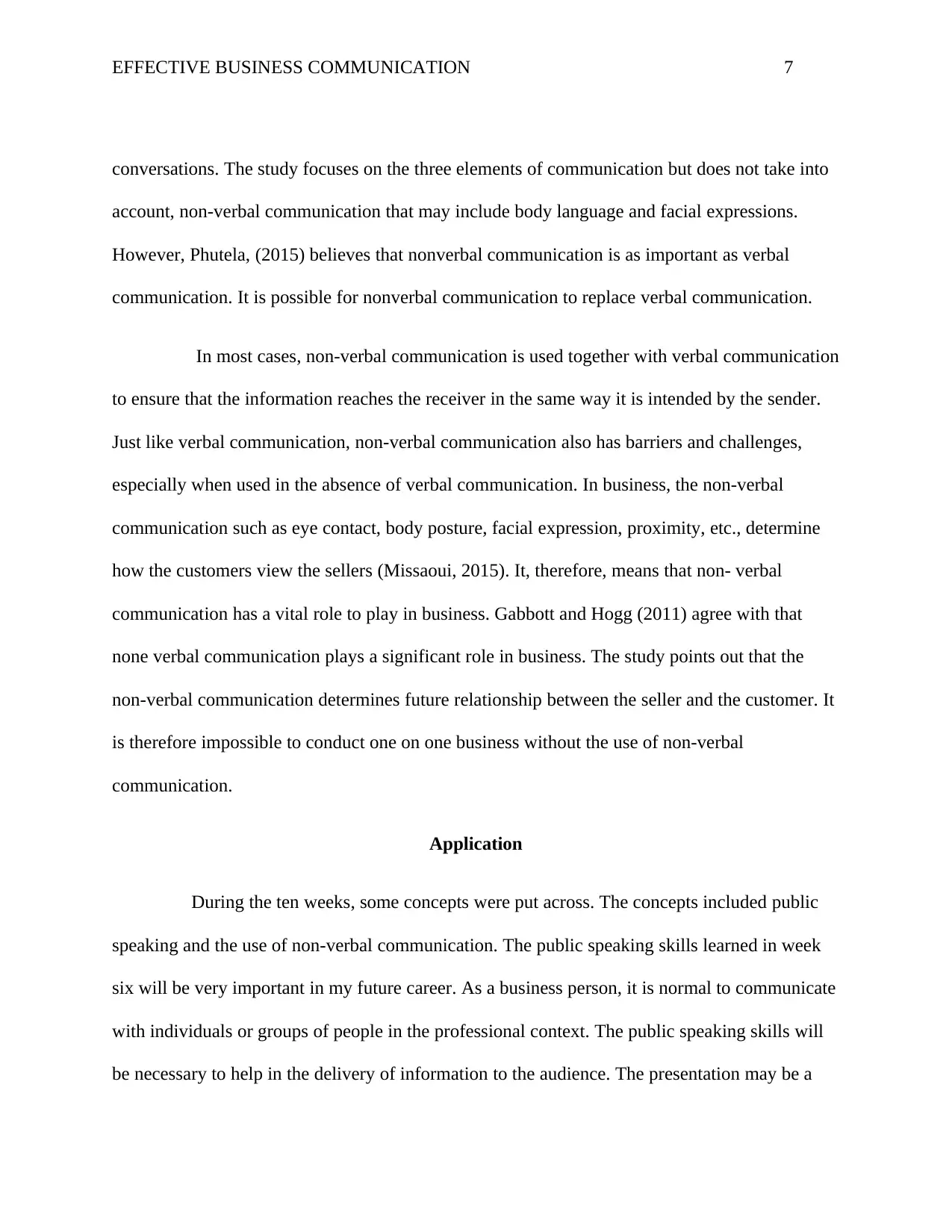
EFFECTIVE BUSINESS COMMUNICATION 7
conversations. The study focuses on the three elements of communication but does not take into
account, non-verbal communication that may include body language and facial expressions.
However, Phutela, (2015) believes that nonverbal communication is as important as verbal
communication. It is possible for nonverbal communication to replace verbal communication.
In most cases, non-verbal communication is used together with verbal communication
to ensure that the information reaches the receiver in the same way it is intended by the sender.
Just like verbal communication, non-verbal communication also has barriers and challenges,
especially when used in the absence of verbal communication. In business, the non-verbal
communication such as eye contact, body posture, facial expression, proximity, etc., determine
how the customers view the sellers (Missaoui, 2015). It, therefore, means that non- verbal
communication has a vital role to play in business. Gabbott and Hogg (2011) agree with that
none verbal communication plays a significant role in business. The study points out that the
non-verbal communication determines future relationship between the seller and the customer. It
is therefore impossible to conduct one on one business without the use of non-verbal
communication.
Application
During the ten weeks, some concepts were put across. The concepts included public
speaking and the use of non-verbal communication. The public speaking skills learned in week
six will be very important in my future career. As a business person, it is normal to communicate
with individuals or groups of people in the professional context. The public speaking skills will
be necessary to help in the delivery of information to the audience. The presentation may be a
conversations. The study focuses on the three elements of communication but does not take into
account, non-verbal communication that may include body language and facial expressions.
However, Phutela, (2015) believes that nonverbal communication is as important as verbal
communication. It is possible for nonverbal communication to replace verbal communication.
In most cases, non-verbal communication is used together with verbal communication
to ensure that the information reaches the receiver in the same way it is intended by the sender.
Just like verbal communication, non-verbal communication also has barriers and challenges,
especially when used in the absence of verbal communication. In business, the non-verbal
communication such as eye contact, body posture, facial expression, proximity, etc., determine
how the customers view the sellers (Missaoui, 2015). It, therefore, means that non- verbal
communication has a vital role to play in business. Gabbott and Hogg (2011) agree with that
none verbal communication plays a significant role in business. The study points out that the
non-verbal communication determines future relationship between the seller and the customer. It
is therefore impossible to conduct one on one business without the use of non-verbal
communication.
Application
During the ten weeks, some concepts were put across. The concepts included public
speaking and the use of non-verbal communication. The public speaking skills learned in week
six will be very important in my future career. As a business person, it is normal to communicate
with individuals or groups of people in the professional context. The public speaking skills will
be necessary to help in the delivery of information to the audience. The presentation may be a
Paraphrase This Document
Need a fresh take? Get an instant paraphrase of this document with our AI Paraphraser
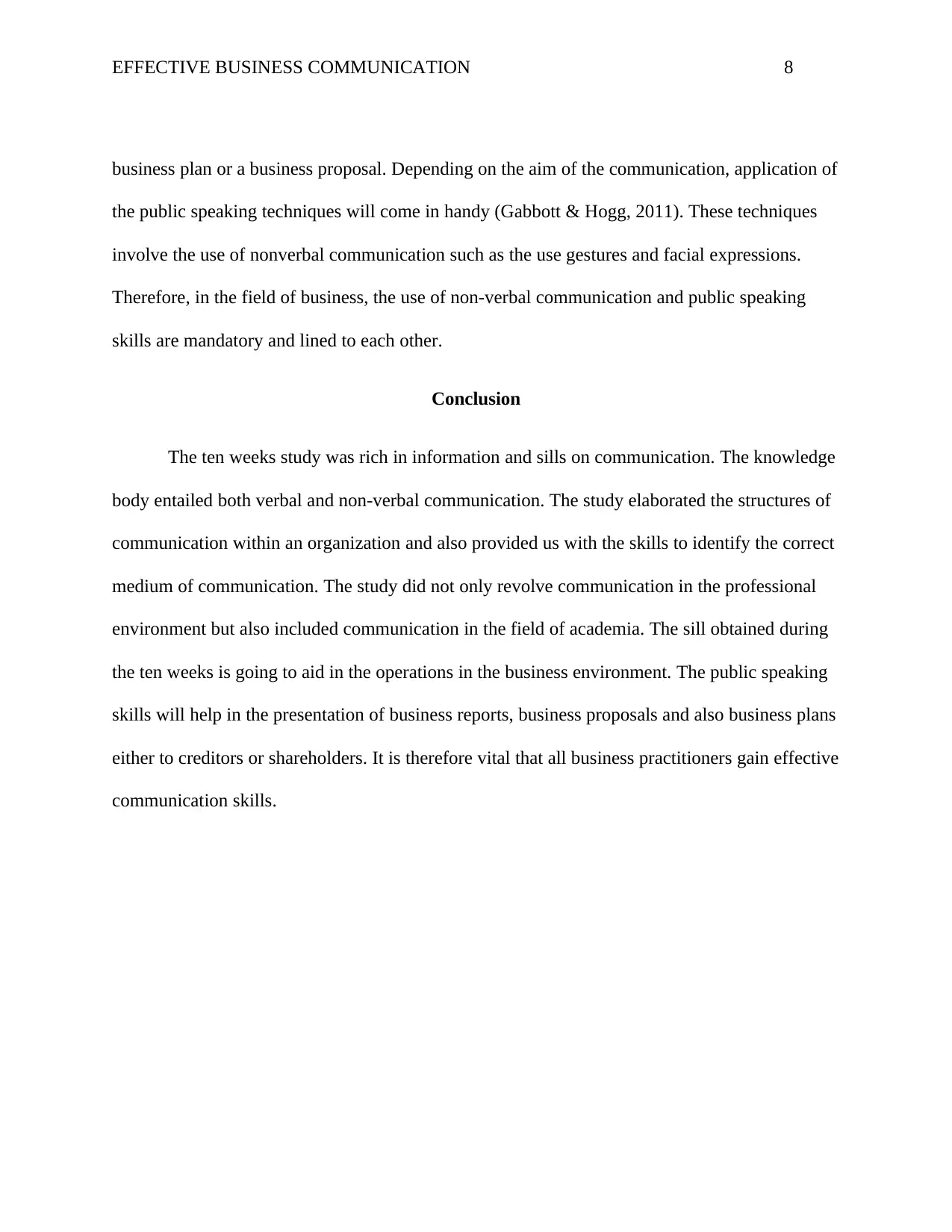
EFFECTIVE BUSINESS COMMUNICATION 8
business plan or a business proposal. Depending on the aim of the communication, application of
the public speaking techniques will come in handy (Gabbott & Hogg, 2011). These techniques
involve the use of nonverbal communication such as the use gestures and facial expressions.
Therefore, in the field of business, the use of non-verbal communication and public speaking
skills are mandatory and lined to each other.
Conclusion
The ten weeks study was rich in information and sills on communication. The knowledge
body entailed both verbal and non-verbal communication. The study elaborated the structures of
communication within an organization and also provided us with the skills to identify the correct
medium of communication. The study did not only revolve communication in the professional
environment but also included communication in the field of academia. The sill obtained during
the ten weeks is going to aid in the operations in the business environment. The public speaking
skills will help in the presentation of business reports, business proposals and also business plans
either to creditors or shareholders. It is therefore vital that all business practitioners gain effective
communication skills.
business plan or a business proposal. Depending on the aim of the communication, application of
the public speaking techniques will come in handy (Gabbott & Hogg, 2011). These techniques
involve the use of nonverbal communication such as the use gestures and facial expressions.
Therefore, in the field of business, the use of non-verbal communication and public speaking
skills are mandatory and lined to each other.
Conclusion
The ten weeks study was rich in information and sills on communication. The knowledge
body entailed both verbal and non-verbal communication. The study elaborated the structures of
communication within an organization and also provided us with the skills to identify the correct
medium of communication. The study did not only revolve communication in the professional
environment but also included communication in the field of academia. The sill obtained during
the ten weeks is going to aid in the operations in the business environment. The public speaking
skills will help in the presentation of business reports, business proposals and also business plans
either to creditors or shareholders. It is therefore vital that all business practitioners gain effective
communication skills.
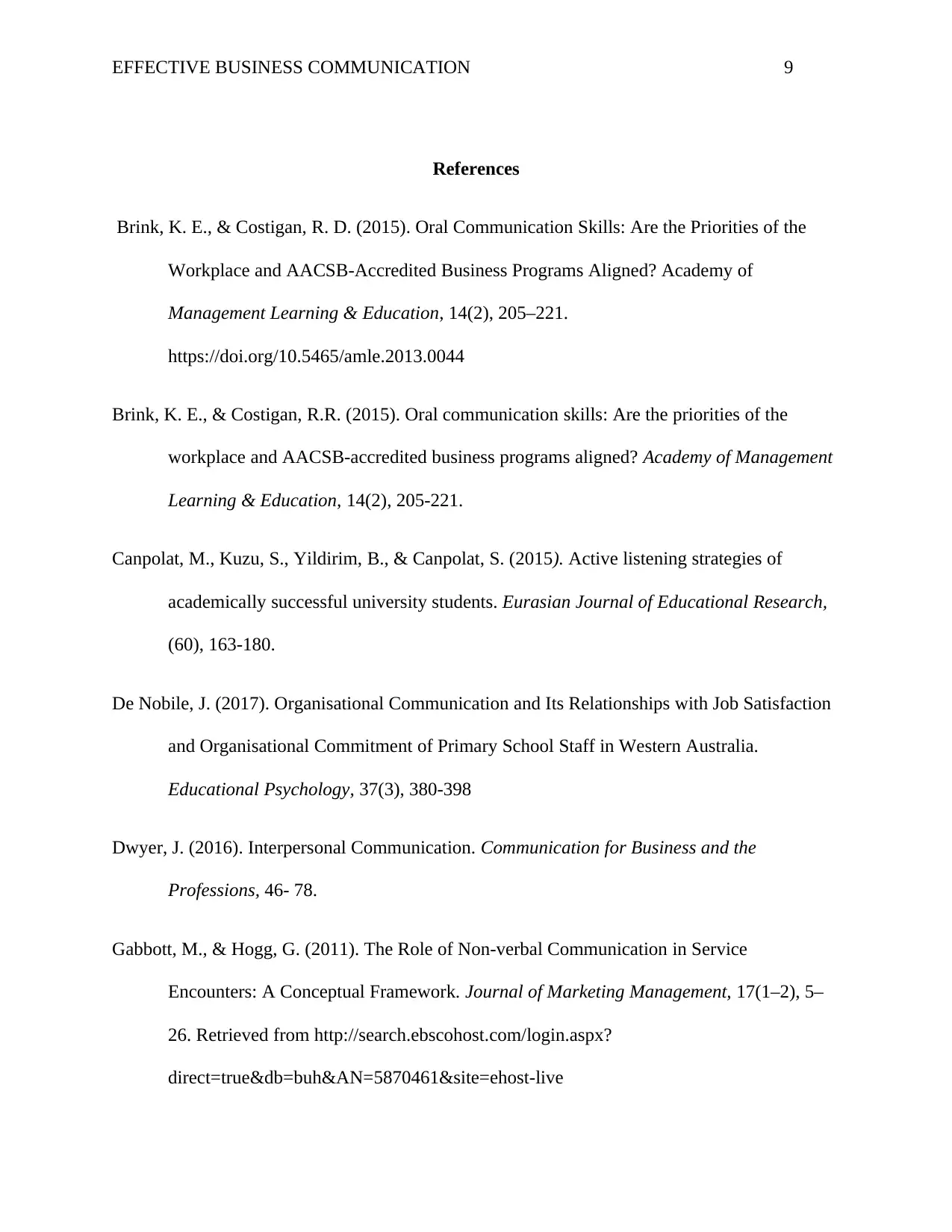
EFFECTIVE BUSINESS COMMUNICATION 9
References
Brink, K. E., & Costigan, R. D. (2015). Oral Communication Skills: Are the Priorities of the
Workplace and AACSB-Accredited Business Programs Aligned? Academy of
Management Learning & Education, 14(2), 205–221.
https://doi.org/10.5465/amle.2013.0044
Brink, K. E., & Costigan, R.R. (2015). Oral communication skills: Are the priorities of the
workplace and AACSB-accredited business programs aligned? Academy of Management
Learning & Education, 14(2), 205-221.
Canpolat, M., Kuzu, S., Yildirim, B., & Canpolat, S. (2015). Active listening strategies of
academically successful university students. Eurasian Journal of Educational Research,
(60), 163-180.
De Nobile, J. (2017). Organisational Communication and Its Relationships with Job Satisfaction
and Organisational Commitment of Primary School Staff in Western Australia.
Educational Psychology, 37(3), 380-398
Dwyer, J. (2016). Interpersonal Communication. Communication for Business and the
Professions, 46- 78.
Gabbott, M., & Hogg, G. (2011). The Role of Non-verbal Communication in Service
Encounters: A Conceptual Framework. Journal of Marketing Management, 17(1–2), 5–
26. Retrieved from http://search.ebscohost.com/login.aspx?
direct=true&db=buh&AN=5870461&site=ehost-live
References
Brink, K. E., & Costigan, R. D. (2015). Oral Communication Skills: Are the Priorities of the
Workplace and AACSB-Accredited Business Programs Aligned? Academy of
Management Learning & Education, 14(2), 205–221.
https://doi.org/10.5465/amle.2013.0044
Brink, K. E., & Costigan, R.R. (2015). Oral communication skills: Are the priorities of the
workplace and AACSB-accredited business programs aligned? Academy of Management
Learning & Education, 14(2), 205-221.
Canpolat, M., Kuzu, S., Yildirim, B., & Canpolat, S. (2015). Active listening strategies of
academically successful university students. Eurasian Journal of Educational Research,
(60), 163-180.
De Nobile, J. (2017). Organisational Communication and Its Relationships with Job Satisfaction
and Organisational Commitment of Primary School Staff in Western Australia.
Educational Psychology, 37(3), 380-398
Dwyer, J. (2016). Interpersonal Communication. Communication for Business and the
Professions, 46- 78.
Gabbott, M., & Hogg, G. (2011). The Role of Non-verbal Communication in Service
Encounters: A Conceptual Framework. Journal of Marketing Management, 17(1–2), 5–
26. Retrieved from http://search.ebscohost.com/login.aspx?
direct=true&db=buh&AN=5870461&site=ehost-live
⊘ This is a preview!⊘
Do you want full access?
Subscribe today to unlock all pages.

Trusted by 1+ million students worldwide
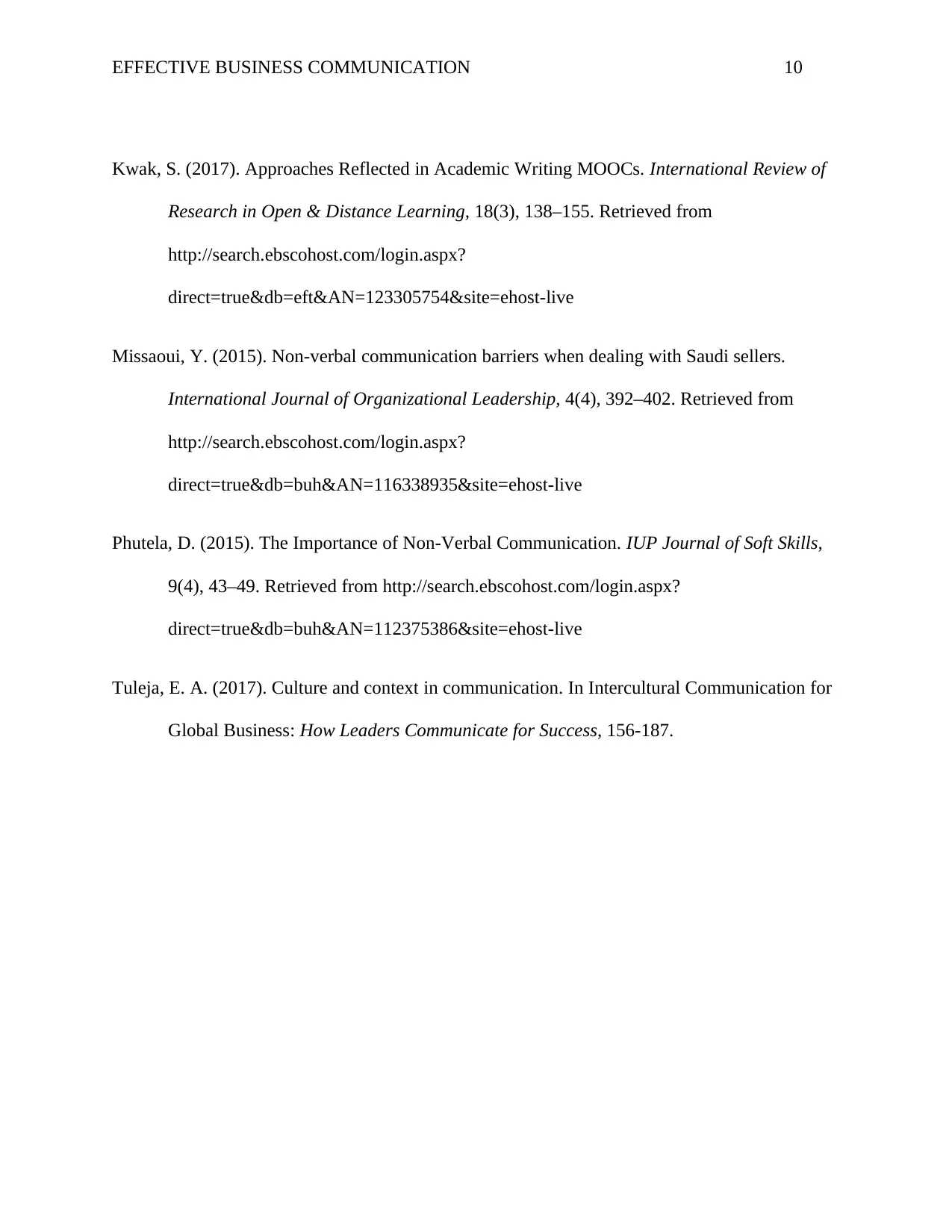
EFFECTIVE BUSINESS COMMUNICATION 10
Kwak, S. (2017). Approaches Reflected in Academic Writing MOOCs. International Review of
Research in Open & Distance Learning, 18(3), 138–155. Retrieved from
http://search.ebscohost.com/login.aspx?
direct=true&db=eft&AN=123305754&site=ehost-live
Missaoui, Y. (2015). Non-verbal communication barriers when dealing with Saudi sellers.
International Journal of Organizational Leadership, 4(4), 392–402. Retrieved from
http://search.ebscohost.com/login.aspx?
direct=true&db=buh&AN=116338935&site=ehost-live
Phutela, D. (2015). The Importance of Non-Verbal Communication. IUP Journal of Soft Skills,
9(4), 43–49. Retrieved from http://search.ebscohost.com/login.aspx?
direct=true&db=buh&AN=112375386&site=ehost-live
Tuleja, E. A. (2017). Culture and context in communication. In Intercultural Communication for
Global Business: How Leaders Communicate for Success, 156-187.
Kwak, S. (2017). Approaches Reflected in Academic Writing MOOCs. International Review of
Research in Open & Distance Learning, 18(3), 138–155. Retrieved from
http://search.ebscohost.com/login.aspx?
direct=true&db=eft&AN=123305754&site=ehost-live
Missaoui, Y. (2015). Non-verbal communication barriers when dealing with Saudi sellers.
International Journal of Organizational Leadership, 4(4), 392–402. Retrieved from
http://search.ebscohost.com/login.aspx?
direct=true&db=buh&AN=116338935&site=ehost-live
Phutela, D. (2015). The Importance of Non-Verbal Communication. IUP Journal of Soft Skills,
9(4), 43–49. Retrieved from http://search.ebscohost.com/login.aspx?
direct=true&db=buh&AN=112375386&site=ehost-live
Tuleja, E. A. (2017). Culture and context in communication. In Intercultural Communication for
Global Business: How Leaders Communicate for Success, 156-187.
1 out of 10
Related Documents
Your All-in-One AI-Powered Toolkit for Academic Success.
+13062052269
info@desklib.com
Available 24*7 on WhatsApp / Email
![[object Object]](/_next/static/media/star-bottom.7253800d.svg)
Unlock your academic potential
Copyright © 2020–2025 A2Z Services. All Rights Reserved. Developed and managed by ZUCOL.



